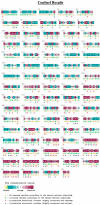Investigation of TLR2 and TLR4 Polymorphisms and Sepsis Susceptibility: Computational and Experimental Approaches
- PMID: 36142893
- PMCID: PMC9504743
- DOI: 10.3390/ijms231810982
Investigation of TLR2 and TLR4 Polymorphisms and Sepsis Susceptibility: Computational and Experimental Approaches
Abstract
Toll-like receptors (TLR) play an eminent role in the regulation of immune responses to invading pathogens during sepsis. TLR genetic variants might influence individual susceptibility to developing sepsis. The current study aimed to investigate the association of genetic polymorphisms of the TLR2 and TLR4 with the risk of developing sepsis with both a pilot study and in silico tools. Different in silico tools were used to predict the impact of our SNPs on protein structure, stability, and function. Furthermore, in our prospective study, all patients matching the inclusion criteria in the intensive care units (ICU) were included and followed up, and DNA samples were genotyped using real-time polymerase chain reaction (RT-PCR) technology. There was a significant association between TLR2 Arg753Gln polymorphisms and sepsis under the over-dominant model (p = 0.043). In contrast, we did not find a significant difference with the TLR4 Asp299Gly polymorphism with sepsis. However, there was a significant association between TLR4 Asp299Gly polymorphisms and Acinetobacter baumannii infection which is quite a virulent organism in ICU (p = 0.001) and post-surgical cohorts (p = 0.033). Our results conclude that the TLR2 genotype may be a risk factor for sepsis in adult patients.
Keywords: TLR; infection; polymorphism; sepsis; septic shock.
Conflict of interest statement
The authors declare no conflict of interest.
Figures






Similar articles
-
Polymorphisms of the toll-like receptor 2 and 4 genes are associated with faster progression and a more severe course of sepsis in critically ill patients.J Int Med Res. 2014 Feb;42(1):93-110. doi: 10.1177/0300060513504358. Epub 2013 Dec 23. J Int Med Res. 2014. PMID: 24366499
-
Clinical Implication of Toll-Like Receptors (TLR2 and TLR4) in Acute Myeloid Leukemia Patients.Asian Pac J Cancer Prev. 2020 Nov 1;21(11):3177-3183. doi: 10.31557/APJCP.2020.21.11.3177. Asian Pac J Cancer Prev. 2020. PMID: 33247673 Free PMC article.
-
Toll-like receptor 2, 4 and 9 polymorphisms and their association with ICU-acquired infections in Central Greece.J Crit Care. 2018 Oct;47:1-8. doi: 10.1016/j.jcrc.2018.05.012. Epub 2018 May 25. J Crit Care. 2018. PMID: 29860039
-
[Gene polymorphisms of Toll-like receptors in Chinese Han children with sepsis in Wenzhou].Zhonghua Er Ke Za Zhi. 2010 Jan;48(1):15-8. Zhonghua Er Ke Za Zhi. 2010. PMID: 20441696 Chinese.
-
Genetic polymorphisms associated with sepsis incidence, severity, and outcomes among neonates: A mini-review.J Adv Pharm Technol Res. 2023 Oct-Dec;14(4):289-293. doi: 10.4103/JAPTR.JAPTR_332_23. Epub 2023 Oct 30. J Adv Pharm Technol Res. 2023. PMID: 38107458 Free PMC article. Review.
Cited by
-
A chronic murine model of pulmonary Acinetobacter baumannii infection enabling the investigation of late virulence factors, long-term antibiotic treatments, and polymicrobial infections.bioRxiv [Preprint]. 2024 Sep 18:2024.09.17.613469. doi: 10.1101/2024.09.17.613469. bioRxiv. 2024. Update in: Nat Commun. 2025 Aug 15;16(1):7617. doi: 10.1038/s41467-025-62655-4. PMID: 39345519 Free PMC article. Updated. Preprint.
-
Unraveling Extremely Damaging IRAK4 Variants and Their Potential Implications for IRAK4 Inhibitor Efficacy.J Pers Med. 2023 Nov 26;13(12):1648. doi: 10.3390/jpm13121648. J Pers Med. 2023. PMID: 38138875 Free PMC article.
-
The Role of Toll-like Receptors (TLRs) and Their Related Signaling Pathways in Viral Infection and Inflammation.Int J Mol Sci. 2023 Apr 4;24(7):6701. doi: 10.3390/ijms24076701. Int J Mol Sci. 2023. PMID: 37047674 Free PMC article.
-
TLRs Gene Polymorphisms Associated with Pneumonia before and during COVID-19 Pandemic.Diagnostics (Basel). 2022 Dec 30;13(1):121. doi: 10.3390/diagnostics13010121. Diagnostics (Basel). 2022. PMID: 36611413 Free PMC article.
-
Toll-like receptors in health and disease.MedComm (2020). 2024 Apr 29;5(5):e549. doi: 10.1002/mco2.549. eCollection 2024 May. MedComm (2020). 2024. PMID: 38685971 Free PMC article. Review.
References
-
- Nachtigall I., Tamarkin A., Tafelski S., Weimann A., Rothbart A., Heim S., Wernecke K.D., Spies C. Polymorphisms of the toll-like receptor 2 and 4 genes are associated with faster progression and a more severe course of sepsis in critically ill patients. J. Int. Med. Res. 2014;42:93–110. doi: 10.1177/0300060513504358. - DOI - PubMed
-
- Singer M., Deutschman C.S., Seymour C.W., Shankar-Hari M., Annane D., Bauer M., Bellomo R., Bernard G.R., Chiche J.-D., Coopersmith C.M., et al. The Third International Consensus Definitions for Sepsis and Septic Shock (Sepsis-3) JAMA. 2016;315:801–810. doi: 10.1001/jama.2016.0287. - DOI - PMC - PubMed
MeSH terms
Substances
LinkOut - more resources
Full Text Sources
Medical

